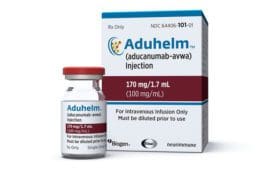 Scholar Rock recently announced Q2 results, highlighting continued progress in its Phase 3 SAPPHIRE trial for the selective myostatin-inhibitor apitegromab in spinal muscular atrophy (SMA). SAPPHIRE is a randomized, double-blind, placebo-controlled study.
Scholar Rock recently announced Q2 results, highlighting continued progress in its Phase 3 SAPPHIRE trial for the selective myostatin-inhibitor apitegromab in spinal muscular atrophy (SMA). SAPPHIRE is a randomized, double-blind, placebo-controlled study.
The Cambridge, Massachusetts–based company also shared new data from its Phase 2 TOPAZ trial focused on apitegromab that showed significant and sustained improvement in Hammersmith Functional Motor Scale-Expanded (HFMSE) scores at 24 months for non-ambulatory patients. The HFMSE scores continued to improve for patients who moved from 2 mg/kg to 20 mg/kg in Cohort 3 in the second year of the study. In addition, patients continued to see increases in Revised Upper Limb Module (RULM) scores at 24 months.
The HFMSE is an assessment for spinal muscular atrophy types 2 and 3 comprising 33 distinct activities scored 0, 1 or 2. HFMSE measures common activities such as lying and rolling, crawling, kneeling and standing. “These are things that are easy to take for granted in healthy children, but in the case of SMA, it’s not self-evident, for instance, that a child can roll from side to side,” said Nagesh Mahanthappa, interim CEO in an interview. “That has really important consequences. For children who do not have that ability, a parent or caregiver must come in every few hours over the course of the night and shift the child around to make sure the child doesn’t develop bed sores.”
Hammersmith Functional Motor Scale and quality of life
A one-point increase in the HFMSE assessment can have a measurable impact on quality of life. “What we aimed for in TOPAZ was to see a three-point or greater increase,” Mahanthappa said. “We knew from the natural history data of patients untreated or on survival of motor neuron (SMN) upregulators such as nusinersen that a spontaneous increase of three points or more would be highly statistically unlikely.”

Nagesh Mahanthappa,
Apitegromab recipients in the 12-month TOPAZ study had HFMSE increases by over three points on average.
Most patients enrolled in the Phase 2 TOPAZ volunteered to continue in the open-label extension portion of the study. Those HFMSE improvements persisted.
The SAPPHIRE study includes two drug dose levels in addition to placebo, 10 milligrams per kilogram and 20 milligrams per kilogram. However, “20 milligrams was our top dose in the TOPAZ study where we saw what appeared to be a maximal effect,” Mahanthappa said.
“Even to see stability in the motor function gains that the patients achieved at 12 months would have been considered a real win,” Mahanthappa said. “That is exactly what we saw in the primary outcome measure with the Hammersmith Functional Motor Scale.”
Apitegromab recipients saw robust, stable gains overall.
Non-ambulatory patients who had lost the ability to walk before enrollment in the study over the course of 24 months had “robust, sustained gains in the Hammersmith scale,” Mahanthappa noted.
The Revised Upper Limb Module scale
The study also used the Revised Upper Limb Module (RULM) for spinal muscular atrophy to assess functionality. The assessment tracks activities closely aligned with activities of daily living. Examples include being able to push a button or lift a cup to the mouth. “These are meaningful activities for maintaining autonomy and dignity as an individual,” Mahanthappa said.
“At 24 months, we saw increases in the scores of the patients on the Revised Upper Limb Module,” Mahanthappa said. “So for us, it validated that the results at 12 months are real. The patients are continuing to benefit from apitegromab.”
The data “adds energy and belief to what we’re now doing in Phase 3 pivotal SAPPHIRE trial,” Mahanthappa said.
Apitegromab and the treatment landscape for SMA
SMA results from a fundamental defect involving a mutation in the gene called SMN-1. A closely related gene called SMN-2 produces a protein that is functionally equivalent to SMN-1. “But the SMN-2 gene does it with low efficiency,” Mahanthappa said. “So, in patients with SMA who lost their functional SMN-1 gene, a therapeutic strategy that’s been approached multiple ways has been either to soup up the expression of the SMN-2 gene — up-regulating the SMN protein.” That can be done either with an oligonucleotide like nusinersen or a small molecule like risdiplam. A third strategy involves gene therapy, which provides the patient with a functional gene that makes the normal SMN-1 protein.
“In all three cases, you’re effectively replacing the loss of that SMN protein,” Mahanthappa said. “The loss of that SMN protein, for reasons that aren’t completely understood, results in the death of motor neurons in the spinal cord.”
The death of motor neurons results in a loss of the connection between the nervous system and skeletal muscle, resulting in muscle atrophy.
The goal of nusinersen, risdiplam or gene therapy is to maintain motor neuron survival and therefore maintain muscle conductivity.
“Unfortunately, none of these medicines is a cure per se — even in the case of the gene therapy,” Mahanthappa said. “So across the board, we felt there was a significant opportunity for a therapeutic that would actually be complementary and would be muscle-directed, muscle-targeted and have a direct impact on the muscle.”
Scholar Rock anticipates that the combination of maintaining the survival of the motor neurons with SMN upregulators or gene therapy, in conjunction with a muscle-targeted therapy, will give rise to a more robust result. “So, stronger muscle, more functional muscle, and perhaps by the muscle being healthy, that would also promote longer-term survival of neurons,” Mahanthappa said.
Filed Under: Neurological Disease





Tell Us What You Think!
You must be logged in to post a comment.